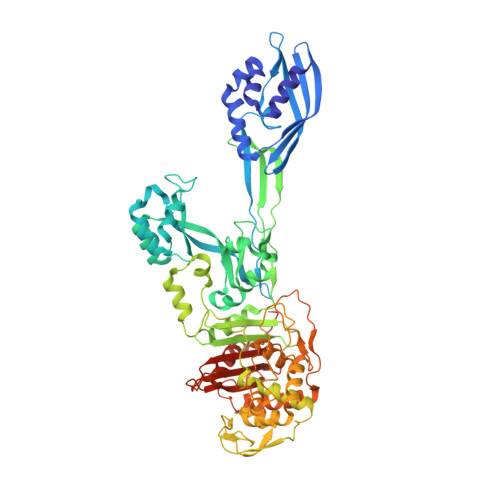Conformational Dynamics in Penicillin-Binding Protein 2a of Methicillin-Resistant Staphylococcus aureus, Allosteric Communication Network and Enablement of Catalysis.
Mahasenan, K.V., Molina, R., Bouley, R., Batuecas, M.T., Fisher, J.F., Hermoso, J.A., Chang, M., Mobashery, S.(2017) J Am Chem Soc 139: 2102-2110
- PubMed: 28099001
- DOI: https://doi.org/10.1021/jacs.6b12565
- Primary Citation of Related Structures:
5M18, 5M19, 5M1A - PubMed Abstract:
The mechanism of the β-lactam antibacterials is the functionally irreversible acylation of the enzymes that catalyze the cross-linking steps in the biosynthesis of their peptidoglycan cell wall. The Gram-positive pathogen Staphylococcus aureus uses one primary resistance mechanism. An enzyme, called penicillin-binding protein 2a (PBP2a), is brought into this biosynthetic pathway to complete the cross-linking. PBP2a effectively discriminates against the β-lactam antibiotics as potential inhibitors, and in favor of the peptidoglycan substrate. The basis for this discrimination is an allosteric site, distal from the active site, that when properly occupied concomitantly opens the gatekeeper residues within the active site and realigns the conformation of key residues to permit catalysis. We address the molecular basis of this regulation using crystallographic studies augmented by computational analyses. The crystal structures of three β-lactams (oxacillin, cefepime, ceftazidime) complexes with PBP2a-each with the β-lactam in the allosteric site-defined (with preceding PBP2a structures) as the "open" or "partially open" PBP2a states. A particular loop motion adjacent to the active site is identified as the driving force for the active-site conformational change that accompanies active-site opening. Correlation of this loop motion to effector binding at the allosteric site, in order to identify the signaling pathway, was accomplished computationally in reference to the known "closed" apo-PBP2a X-ray crystal structure state. This correlation enabled the computational simulation of the structures coinciding with initial peptidoglycan substrate binding to PBP2a, acyl enzyme formation, and acyl transfer to a second peptidoglycan substrate to attain cross-linking. These studies offer important insights into the structural bases for allosteric site-to-active site communication and for β-lactam mimicry of the peptidoglycan substrates, as foundational to the mechanistic understanding of emerging PBP2a resistance mutations.
Organizational Affiliation:
Department of Chemistry and Biochemistry, University of Notre Dame , Notre Dame, Indiana 46556, United States.
















